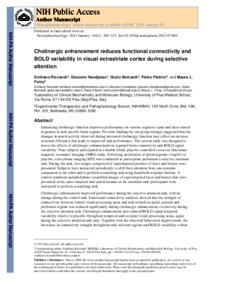Sizonenko, Stéphane V. and Babilon, Claudio and de Bruin, Eveline and Isaacs, Elizabeth B. and Jönsson, Lena S. and Kennedy, David O. and Latulippe, Marie E. and Mohajeri, M. Hasan and Moreines, Judith and Pietrini, Pietro and Walhovd, Kristine B. and Winwood, Robert J. and Sijben, John W.
Brain imaging and human nutrition: which measures to use in intervention studies?
British Journal of Nutrition, 110.
S1-S30.
ISSN 0007-1145
(2013)
![[img]](http://eprints.imtlucca.it/2887/1.hassmallThumbnailVersion/nihms402285.pdf)  Preview |
|
PDF (https://www.ncbi.nlm.nih.gov/pmc/articles/PMC3445804/pdf/nihms402285.pdf)
- Submitted Version
Download (4MB)
| Preview
|
Abstract
The present review describes brain imaging technologies that can be used to assess the effects of nutritional interventions in human subjects. Specifically, we summarise the biological relevance of their outcome measures, practical use and feasibility, and recommended use in short- and long-term nutritional studies. The brain imaging technologies described consist of MRI, including diffusion tensor imaging, magnetic resonance spectroscopy and functional MRI, as well as electroencephalography/magnetoencephalography, near-IR spectroscopy, positron emission tomography and single-photon emission computerised tomography. In nutritional interventions and across the lifespan, brain imaging can detect macro- and microstructural, functional, electrophysiological and metabolic changes linked to broader functional outcomes, such as cognition. Imaging markers can be considered as specific for one or several brain processes and as surrogate instrumental endpoints that may provide sensitive measures of short- and long-term effects. For the majority of imaging measures, little information is available regarding their correlation with functional endpoints in healthy subjects; therefore, imaging markers generally cannot replace clinical endpoints that reflect the overall capacity of the brain to behaviourally respond to specific situations and stimuli. The principal added value of brain imaging measures for human nutritional intervention studies is their ability to provide unique in vivo information on the working mechanism of an intervention in hypothesis-driven research. Selection of brain imaging techniques and target markers within a given technique should mainly depend on the hypothesis regarding the mechanism of action of the intervention, level (structural, metabolic or functional) and anticipated timescale of the intervention's effects, target population, availability and costs of the techniques.
Actions (login required)
 |
Edit Item |



